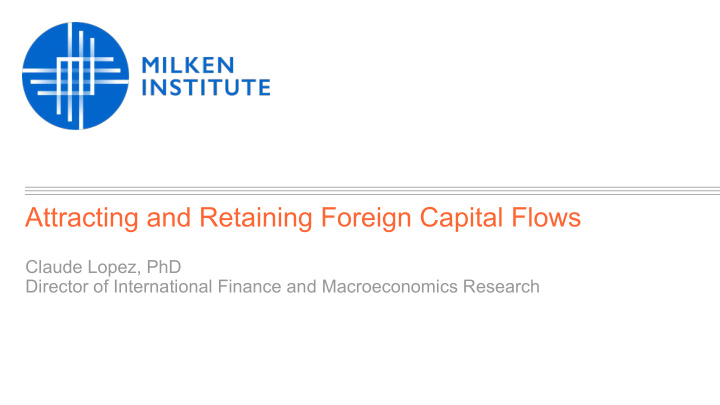



Attracting and Retaining Foreign Capital Flows Claude Lopez, PhD Director of International Finance and Macroeconomics Research
Global Capital Inflows by Destination 2
The Reversal Observed Is Asset-Specific 3
And Country-Specific 4
How to Reassure Investors While Strengthening the Resilience of the Financial System? 5
At the Country Level Source: Global Opportunity Index 2018, Milken Institute 6
At the Country Level Business Perception : key issues center on how costly it is to run a business, the ability and speed • with which the legal system enforces contracts, the level of corruption, interference in hiring and firing practices from labor regulations, and the ease of resolving insolvency. Institutional Framework : This is defined as the availability of relevant and high-quality financial • data (e.g., information needed for assessing the creditworthiness and borrowing capacity of domestic companies and the extent to which there is adequate disclosure of company financial data and activities to investors). Also relevant are the efficacy of the legal system and investor protection rights (e.g., property rights, legal redress rights, and corporate governance). 7
At the Global Level An adaptable and flexible global framework : The global regulatory and monitoring framework • needs to be continually modernized to keep pace with financial innovations, remain pertinent for the needs of the local economy, and facilitate the matching of investment opportunities with the supply of savings. The generalization of international standards and best practices : The continuation of existing • coordination efforts is essential because the availability of reliable and standardized data across the globe is key to effective monitoring of incipient risks. Adequate surveillance also requires countries to build the necessary in-house expertise and monitoring infrastructure. A stronger global data depository : Developing the relevant reporting, supervisory, and regulatory • infrastructures will enable the effective sharing of relevant data and analysis essential for preserving financial stability. Regulatory and monitoring cooperation : The interaction between the different domestic and • international regulators needs to be clarified and formalized, especially when a crisis emerges in a host country that is not deemed to be globally systemic • 8
9
GOI: 5 categories Business Perception measures explicit and implicit costs associated with business operations such as tax burden, transparency, etc. Financial Services measure the size and access to financial services in a country by looking at the country’s financial infrastructure and access to credit. Institutional Framework measures the extent to which an individual country’s institutions provide a supportive framework to businesses. Economic Fundamentals indicate the current economic strength of a country vis-à-vis the global economic outlook. The assessment focuses on the country’s macroeconomic performance, trade openness, quality and structure of the labor force, and modern infrastructure. International Standards and Policy reflects the extent to which a country’s institutions, policies, and legal system facilitate international integration by following international standards. 10
Recommend
More recommend